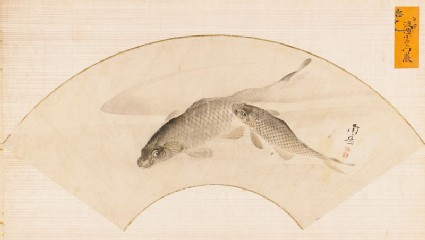Browse: 10610 objects
Two carp swimming in a pool
-
Description
Watanabe Nangaku was an outstanding pupil of Maruyama Ōkyo in Kyoto. From there he took Ōkyo’s new naturalistic style to Edo, where he taught for about three years between 1802 and 1810. He was an eclectic and versatile painter, particularly excelling in bijinga (pictures of beautiful women). He was most famous for his impromptu sketches but also earned a reputation for realistic and carefully brushed paintings of turtles and carp.
-
Details
- Associated place
-
Japan (place of creation)
- Date
- 1801 - 1813
- Artist/maker
-
Watanabe Nangaku (1767 - 1813) (artist)Maruyama-Shijō School (active late 18th century - late 19th century)
- Material and technique
- ink and light colour on paper
- Dimensions
-
mount 36.2 x 55.3 cm (height x width)
painting 24 x 52.5 cm (height x width)
- Material index
- Technique index
- Object type index
- No. of items
- 1
- Credit line
- Presented by Dr Michael Harari, from the collection of his father, Ralph Harari, 1981.
- Accession no.
- EAX.5380
-
Further reading
Katz, Janice, Japanese Paintings in the Ashmolean Museum, Oxford, with an introductory essay by Oliver Impey (Oxford: Ashmolean Museum, 2003), cat. supp. no. 84 on p. 229, illus. p. 229 fig. 84
Hillier, J., The Harari Collection of Japanese Paintings and Drawings, copyright owned by Michael Harari, 3 vols (London: Lund Humphries, 1973), no. 331 on p. 556, illus. p. 558 fig. 331
Past Exhibition
see (1)Location
-
- currently in research collection
Objects are sometimes moved to a different location. Our object location data is usually updated on a monthly basis. Contact the Jameel Study Centre if you are planning to visit the museum to see a particular object on display, or would like to arrange an appointment to see an object in our reserve collections.
© 2013 University of Oxford - Ashmolean Museum


